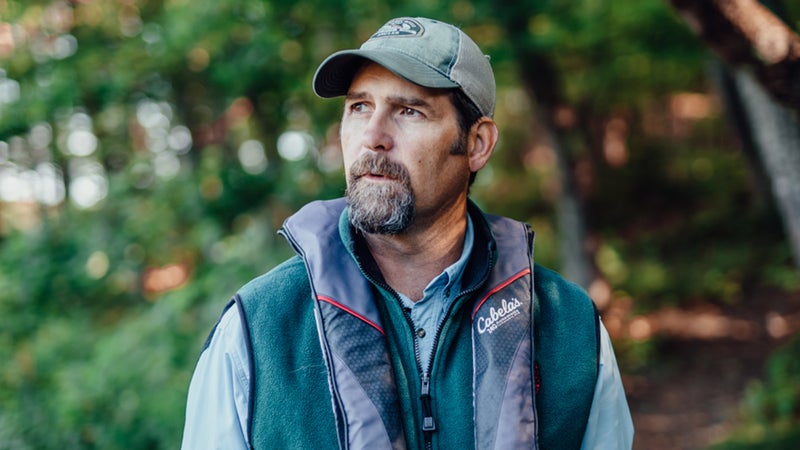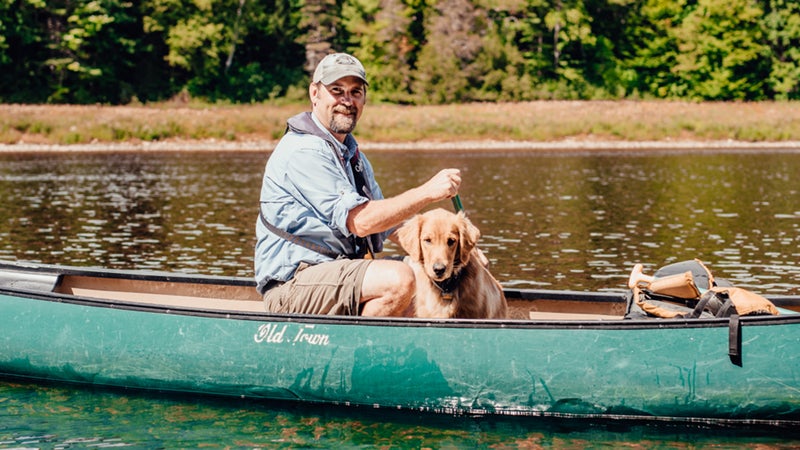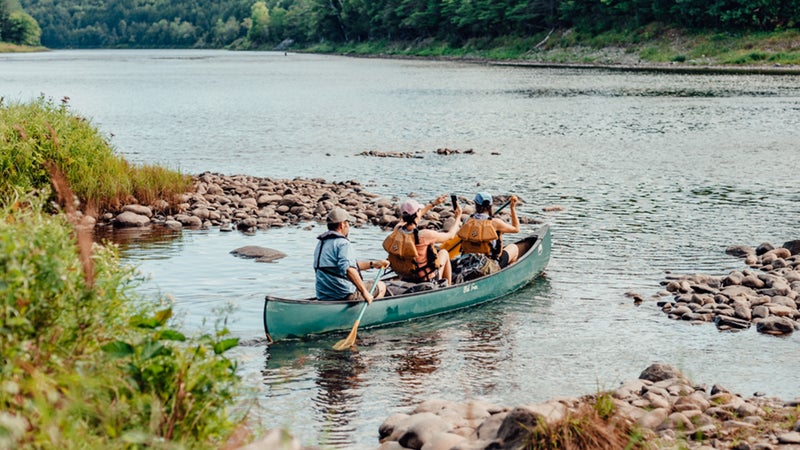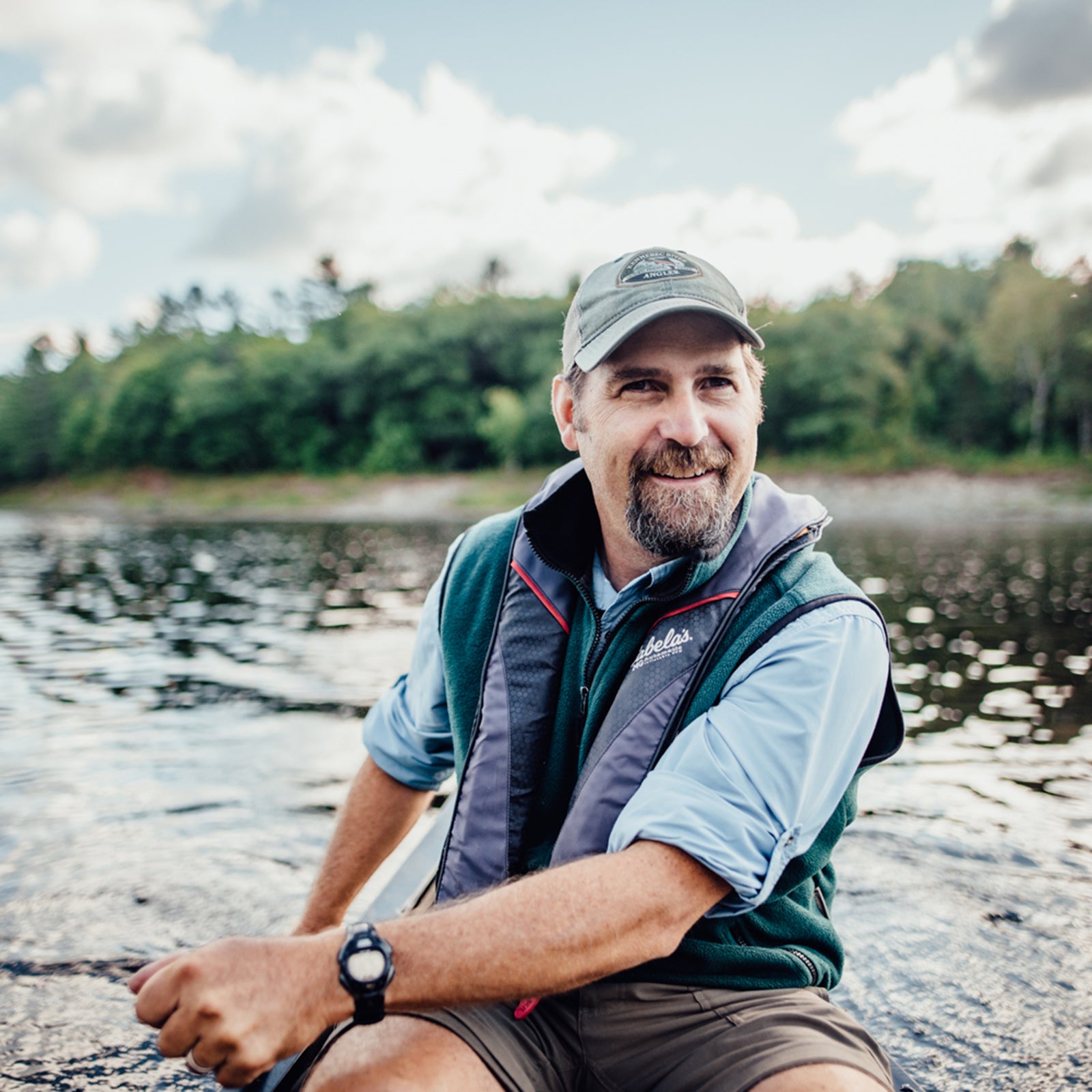ItтАЩs just past 8╠¤A.M. in Caratunk, a tiny town in western Maine. Already╠¤half a dozen have lined up on the west bank of the Kennebec River.╠¤Three hundred feet across, on the opposing bank, two more backpackers wait quietly, their thin legs and gear draped over a fallen log.
At exactly ten minutes to nine, Greg Caruso ambles down a short gravel trail. Caruso, 49, looks exactly like HollywoodтАЩs version of a Maine guide: fit, clean-shaven, wearing Carhartts, water shoes, and a fleece vest. He carries with him a beaten paperback and a dog bowl. Maggie, his two-year-old golden retriever, trots behind. Once they reach the two hikers, Maggie knows the drill. She gives them a quick hi and then gets busy gnawing on a stick. Caruso, meanwhile, turns upright╠¤a battle-scarred canoe.
He unlocks the bike chain that keeps the boat tethered to a slender╠¤maple tree, then pulls out a couple of ripe PFDs╠¤and a clipboard filled with unsigned waivers.
The taller of the two hikers╠¤helps him schlep the 17-foot canoe down to the waterтАЩs edge. From there╠¤we can see that the queue on the other bank is growingтАФabout a dozen hikers now, all standing obediently single file, as if waiting for a carnival ride or an overpriced cup of coffee.

Caruso surveys the╠¤crowd on the opposite bank with a grin. This time of year, itтАЩs the same scene pretty much every morning.
тАЬRush-hour traffic,тАЭ he says.
Thru-hikers on the 2,200-mile Appalachian Trail cross plenty of streams and rivers (Maine alone has over 20 that are 30 feet or wider). Some the hikers must╠¤ford, while others are spanned by everything from boardwalks to elaborate suspension bridges. Only one demands you get in a canoe. For the past four years, Caruso has been the ferryman for that canoe. And that makes him the only official AT river driver╠¤and the only one youтАЩll meet on any of the 11 national scenic trails.
The Kennebec has always been an imposing, capricious river. In 1775, it fouled up Benedict ArnoldтАЩs notorious march on Quebec. When tourists began visiting the area in the late 19th century, an enterprising hotel owner soon realized that the only way to get guests was to ferry them across the river himselfтАФwhich he did for decades, using a flat-bottomed boat. He was still at it when the began siting the nascent trail. An existing ferryman was a lot cheaper than a bridge, so those at the conference╠¤decided to route the trail at this particular crossing.
By World War II, the ferry had fallen out of favor with╠¤paying hotel guests, so the innkeeper discontinued the service. The few hikers who attempted╠¤this section of trail were left to their own devices when it came to crossing, an endeavor that became even more perilous after the 1955 installation of a massive hydroelectric dam:╠¤at 175 feet high and 270 feet across, Harris Station Dam is the largest in the state of Maine. Each day it╠¤releases a wall of waterтАФsometimes as much as 8,000 cubic feet per second. That release creates some of the best whitewater paddling in the East. It also makes it some of the most dangerous.
Throughout the ATтАЩs history, there have been╠¤at least a few drowning near misses, as hikers made bad choices crossing the river. Then, in 1985, Alice and George╠¤Ference, two experienced section hikers, attempted to ford the river. Alice, who did so wearing her full pack, was swept away and drowned. With an increasing╠¤number of hikers on the trail, safety at the Kennebec had already become an issue. FerenceтАЩs death made it an imperative, says Hawk Metheny, Northeast regional director of the ╠¤(┤б░╒░ф).
тАЬPurists want to walk every inch of the trail,тАЭ says Metheny. тАЬSo we designated the canoe as an official part of the AT.тАЭ
The only precedent the group╠¤could find anywhere in the country was the Pacific Northwest Scenic Trail, which requires a 30-minute ride on a car ferry across Puget Sound. But that was a different scale entirely. So it╠¤commissioned a study to consider options.
тАЬWe reviewed everything,тАЭ says Metheny. тАЬWe considered a suspension bridge. We looked at rerouting the trail, installing a zip-line cable car. We wanted to do our due diligence, so everything was on the table.тАЭ
A bridge, it was╠¤soon determined, would not just be prohibitively expensive╠¤but would also require clearing trees and building roads for construction vehicles. And given the massive ice jams╠¤that flow down the river each spring, it just wasnтАЩt viable, unless it╠¤made the span and supporting towers ginormous. A cable car might have been fun, but it hardly fit the rugged character of the AT.
Rerouting the trail to an existing road bridge was definitely the most feasible alternative, says Metheny. It has been done before, at big AT river crossings like the Hudson in New York and the Susquehanna in Pennsylvania. But the whole point of the trail is to get off roads and away from the hustle and bustle of civilization.
And so╠¤in 1987,╠¤the ATC decided to return to the KennebecтАЩs roots and reestablish the ferry system. A local rafting company donated the canoe and some other gear. The ATC hung special warnings urging hikers not to cross on their own (however, each year╠¤about a dozen do anyway). Knowing that hikers are a superstitious lot, the group╠¤also painted a blaze in the bottom of the canoeтАФjust to make it official.
тАЬPurists want to walk every inch of the trail,тАЭ says Metheny. тАЬSo we designated the canoe as an official part of the AT.тАЭ

Today, CarusoтАЩs boat is the only approved way to cross the riverтАФand to complete a thru-hike. ItтАЩs an expensive proposition for the ATC, which doesnтАЩt charge hikers for the trip across the waterway. The service is underwritten in part by the damтАЩs operator, Brookfield Renewable;╠¤like many hydroelectric dams in the U.S., HarrisтАЩs Federal Energy Regulatory Commission license includes a provision for safe recreational opportunities on the river. Usually, that means planned╠¤dam releases for the rafting industry. In this case, it also includes getting hikers across.
At the height of the annual hiking bubble, Caruso works five hours a day,╠¤seven days a week╠¤(compared to╠¤just two hours a day during╠¤the shoulder seasons). ThatтАЩs presented some scheduling challenges, like when ultramarathoner Scott Jurek blew through the area in his 2015 fastest-known-time attempt. He hit the Kennebec at night, long after the ferry was locked up for the day. It took an enterprising local race organizer willing to track down a canoe on social media and drive it across the state to get Jurek across. Had he failed to come through, it could have cost Jurek over ten╠¤hours and possibly the FKT title.
Caruso is the fourth guide to ferry hikers across the river. He grew up in Millinocket, Maine, which sits in the shadow of Mount Katahdin, the ATтАЩs northernmost terminus. Both of his grandparents worked in the former mill there. His uncles and dad did, too. The mill closed its doors before Caruso took his turn. Wilderness guiding, he says, was pretty much the only industry left. He took his first raft-guiding job after a couple years of college.╠¤Twenty-seven years later, he was still guiding hunting, fishing, and rafting trips on the Kennebec and other rivers in the area╠¤when the former ferryman retired. His job, says Caruso, seemed like a pretty good alternative to pushing 2,000 pounds of rubber and people through Class IV rapids every day, so he applied.╠¤
тАЬI mean, where else is an old raft guide going to go?тАЭ he likes to joke.
On a busy day, heтАЩll shuttle 50 hikers back and forth, through the currents and rising water levels.╠¤Other days╠¤heтАЩll sit for hours waiting for a single passenger.
HeтАЩs learned to make adjustments for both. When things get hectic, he deputizes his two sons to get waivers signed and hand out life jackets. When things are slow, heтАЩll fly-fish or dip into a paperback, like╠¤, a lightly fictionalized account of Benedict ArnoldтАЩs attempt up that same river. Caruso has read it cover to cover each of the four seasons heтАЩs been working here.
тАЬNot much has changed in this spot,тАЭ he says. тАЬReading that book, itтАЩs easy to imagine what things were like here in the 1700s.тАЭ
Except, of course, for the boats themselves. His is a fiberglass Old Town canoe with more patches than original glass. ItтАЩs got a few other choice modifications as well. A couple of years ago, Caruso replaced the boatтАЩs center thwart with a cane seat so that he could take two hikers and their gear at a time. He figured most hikers were an emaciated lot and that╠¤the cane would more than support them. He was surprised, then,╠¤to see a╠¤range of body types on the trail. One particularly husky hiker snapped the seat in half. Today╠¤itтАЩs╠¤jury-rigged with enforcements made out of a piece of driftwood, a broken tent pole, and a whole lot of white athletic tape.

HeтАЩs gotten used to the hiker funk, which lingers in the canoe and on the PFDs long after heтАЩs taken his last customer of the day. And he says heтАЩs grown to really value the two minutes or so that he shares with each passenger. Southbound hikers are just 150 miles into their journey when they meet CarusoтАФstill wide-eyed about the trail and sorting out their gear. Most northbounders╠¤are just ten days from finishing and getting that last, euphoric second wind. He says heтАЩs surprised by how many international hikers there are╠¤and how many generations are represented. HeтАЩs taken some of them fishing; others just want to hang out with Maggie for a while. Along the way, heтАЩs memorized where every boulder is on the stretch of water, and he can get even the most uncoordinated hiker in and out of the canoe without dampening the bottom of their shoe.
The current Brookfield energy license and its allowance for the ferry expires in 2036. Metheny hopes a canoe will be moving hikers across the river until thenтАФand well into the future.
тАЬPart of what makes the Appalachian Trail so special is its diversity and unique situations. The ferry has become a part of the cultural experience here,тАЭ says Metheny. тАЬWeтАЩre not just interested in the tangible and the practical.╠¤We also want to preserve the experiential.тАЭ
Last year, Caruso ferried over 2,500 hikers across the river, along with 41 dogs and untold pounds of gear.
тАЬIf I get many more, IтАЩm going to need a party boat. Or at least a second canoe,тАЭ says Caruso. тАЬBut IтАЩm definitely not complaining. Every day is a good day at the office here.тАЭ


